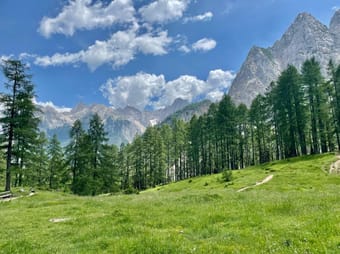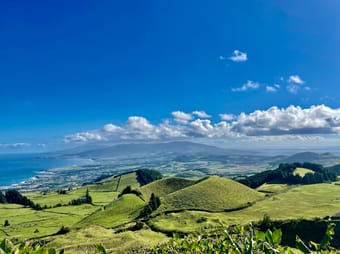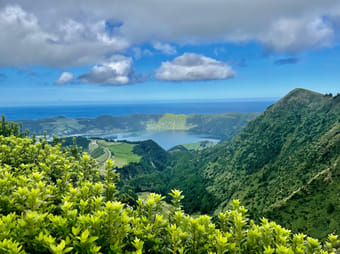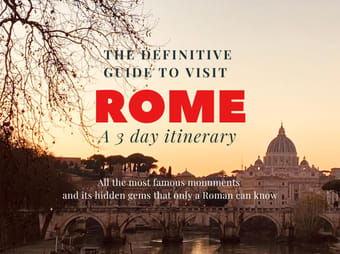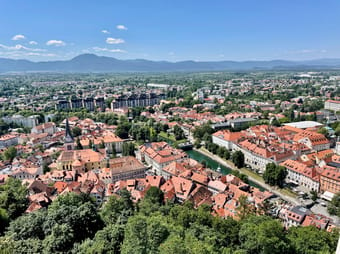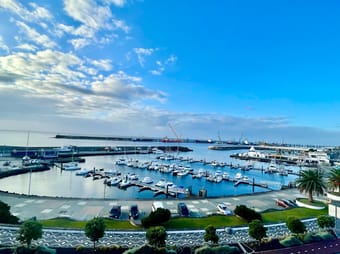Results for Faith
Emerald rivers. Glacial lakes. Hidden karsts. Historic cities. Snow-capped peaks. Sun-drenched beaches. Undiscovered wine regions. Untouched forests. You don't have to traipse all over Europe. The little country of Slovenia features everything you love about the continent in one place. So it's even been nicknamed Little Europe.
Start in the Dragon City. Ljubljana survived Roman, Habsburg, and Yugoslavian rule to become one of the greenest capitals in Europe. Then start exploring hidden caves, medieval towns, scenic drives, and a tiny sliver of coastline. There are adventure sports, award-winning restaurants, grand castles, and stunning views along the way. You'll quickly wonder why it's taken you so long to get here.
The Slovenia Guide works as a great circular road trip through Western Slovenia. Start in Ljubljana, drive north toward the Austrian border, head west toward the Italian border, circle through wine country, and end up back in the capital.
This detailed guide includes:
Places: cities, neighborhoods, towns
Stay: hotels, resorts
Eat: cafés, ice cream, Michelin stars, pizzerias, restaurants
Drink: lounges, wine bars, wineries
Shop: antique markets, toy stores
Do: bell towers, boat tours, bridges, castles, cathedrals, chapels, churches, city models, fountains, funiculars, hikes, history museums, information centers, islands, lakes, libraries, monuments, mountains, mountain ranges, national parks, parks, puppet museums, rivers, roads, squares, statues, streams, ticket offices, valleys, viewpoints, waterfalls
Transportation: airports, parking lots
Adventure • Boutique • Foodie • Outdoors • Road Trip • Wine • Faith • History • Luxury • Relaxation
$30.00
0
There are secret islands in the middle of the North Atlantic Ocean. Nine of them, actually. The Azores are an autonomous region of Portugal, even though they're nearly 900 miles off the coast of Lisbon. Mount Pico, on the island of Pico, is actually the highest point in the European country. The volcanic archipelago is covered with farmland. Small fishing communities line the coasts. Travelers were first introduced to the remote islands when they became a refueling stop for flights between Europe and North America. Direct flights from Boston and New York eventually followed.
The Azores are finally being discovered by North Americans without Portuguese heritage. It's about time. Ponta Delgada, the little capital, mixes historic buildings with modern hotels and restaurants. São Miguel, the main island, is full of hiking trails and hot springs. Pico Island is famous for its wine. While seven other islands are just waiting to be explored. With mild climate, thanks to the jet stream, the Azores are a year-round destination. Go before the secret gets out.
This detailed guide includes:
Places: islands, cities, neighborhoods, towns, hidden villages
Stay: hotels
Eat: bakeries, coffee shops, ice cream stands, pizzerias, restaurants, teahouses
Drink: beach bars, rooftop bars, tapas bars, wineries
Do: abandoned hotels, aqueducts, bamboo groves, beaches, botanical gardens, bridges, chapels, churches, fountains, fumaroles, gardens, gates, hikes, lakes, marinas, mountains, natural swimming pools, nature preserves, public parks, roads, sculptures, squares, statues, tourist offices, UNESCO World Heritage Sites, viewpoints, windmills
Transportation: airports, car rentals, ferries, parking lots
Adventure • Boutique • Design • Foodie • Luxury • Outdoors • People & Culture • Relaxation • Road Trip • Wine • Coffee • Faith • History
$30.00
0
São Miguel Island is the largest--in both size and population--of the Azores. The Green Island was discovered and claimed by the Portuguese in the early 15th century. Mild climate and fertile volcanic soil made the island appealing for settlers. It quickly became an export hub for in-demand sugar. A fishing industry eventually followed. Now it's tourists who are flocking to the island. They're lured by black-sand beaches, hidden hot springs, lake-filled craters, Europe's only tea plantations, quiet hiking trails, volcanic hills, and whale-watching tours. Be sure to spend some time in Ponta Delgada, the easy-to-navigate capital, as well.
This detailed guide includes:
Places: cities, neighborhoods, towns, hidden villages
Stay: hotels
Eat: coffee shops, ice cream stands, restaurants, teahouses
Drink: beach bars, rooftop bars
Do: abandoned hotels, aqueducts, bamboo groves, beaches, botanical gardens, bridges, chapels, churches, fountains, fumaroles, gardens, gates, hikes, lakes, marinas, nature preserves, public parks, roads, sculptures, squares, statues, tourist offices, viewpoints
Transportation: airports, car rentals, parking lots
Adventure • Architecture • Boutique • Foodie • Luxury • Outdoors • People & Culture • Relaxation • Road Trip • Coffee • Faith • History
$25.00
0
Ciao! Let’s explore this ancient city!
Check out this guide if you want to know the best places to stay, the best museums & the best spots for pizza, pasta & gelato!!
This guide is perfect for the first time vistor who wants to soak it all in and has about four to five days!
Architecture • Art • Boutique • Coffee • Foodie • Faith • History • Luxury • People & Culture • Romantic • Wine • Photography • Design
$18.00
0
You get a full list of all the fun spots, museum/tourist must sees, and local hang outs. Plus, foodie must haves!! I will also list accommodations. This itinerary will have mapped out places with phone numbers and addresses that you can keep on your phone. My son lives in Dallas so we go there a lot. Dallas and the surrounding cities are beautiful and fun!! I'm excited to share my travel joy with you, so you can experience the happiness too!!
50+ • Backpacker • Business • Couples • Family • Groups • LGBTQ+ • Adventure • Architecture • Art • Boutique • Budget • Coffee • Design • Faith • Foodie • History • Luxury • Outdoors • People & Culture • Photography • Road Trip • Shopping • Wine
$8.00
0
Why spend hours trying to find where to go? I’ve got it all here. Included is a list of mapped places to stay from RVs sites to luxury hotels, historic places to see, fun places to go, and best places to eat. Plenty of options.
50+ • Accessibility • Couples • Family • Groups • Gluten-free / Celiac • Vegan • Female Solo • Plus Size • LGBTQ+ • Adventure • Architecture • Boutique • Budget • Camping • Coffee • Design • Faith • Foodie • History • Art • Luxury • Outdoors • People & Culture • Photography • RV • Relaxation • Road Trip • Romantic • Shopping • Slow Travel • Van Life • Wine
$8.00
0
Charlotte, NC, has a scene that's perfect for a weekend around town, catering to every style. Whether you're into top-notch restaurants, vibrant nightlife, adventurous spots, the finest bourbon bars, or upscale hotels, Charlotte has all the ingredients for an unforgettable weekend.
50+ • Digital Nomads • LGBTQ+ • Accessibility • Family • Pets • Backpacker • Gluten-free / Celiac • Plus Size • Female Solo • Vegan • Groups • Car-free • Business • Couples • Halal • Vegetarian • Adventure • Coffee • Overlanding • Road Trip • Architecture • Design • People & Culture • Romantic • Van Life • Wellness • Wine • Shopping • Faith • Art • Boutique • Camping • Luxury • RV • Slow Travel • Outdoors • Photography • Relaxation • Sustainable/Eco • Budget • Foodie • History
Free
0
All the most famous monuments of Rome 📸 and its hidden gems that only a Roman can know as well as boutiques 👗 , restaurants 🍝 , street food 🍕 and then how to get to the city from the airport ✈️ , apps that will make your life easier 🗺️ and useful number to always have with you , in short, everything but absolutely everything you need to enjoy your holiday in safety and fun 😁 .
P.s. All photos are mine 😎
Architecture • Art • Boutique • Foodie • History • Shopping • Romantic • Photography • Wine • Coffee • Faith • Adventure
$18.00
0
Ljubljana is the capital and largest city in Slovenia. The Dragon City, which straddles the Ljubljanica River, survived Roman, Habsburg, and Yugoslavian rule to lead the mountainous country into independence. Slovenia has become the Green Heart of Europe, while Ljubljana is one of the greenest capitals on the continent.
This charming city is home to less than 300,000 people. It's a university town, a tech center, and an artist's haven. The Old Town is full of Baroque buildings with red-tiled roofs, detailed bridges, and lively squares. Cafes with terrace seating line the river, which is used by kayakers and sightseeing boats. New hotels, restaurants, and wine bars keep popping up in this car-free area. While Ljubljana Castle stands on a hill overlooking it all.
The compact city is a central base for adventures all over the small country. But best of all: Ljubljana still feels like an under-the-radar destination. Go fall in love with this enchanting city before everyone else catches on.
This detailed guide includes:
Places: neighborhoods
Stay: hotels
Eat: cafés, pizzerias, restaurants
Drink: lounges, wine bars
Shop: antique markets, toy stores
Do: bridges, castles, cathedrals, churches, city models, fountains, funiculars, monuments, parks, puppet museums, rivers, sculptures, squares, statues
Car-free • Boutique • Foodie • Wine • Art • Faith • History • People & Culture • Shopping
$20.00
0
Barcelona, where sun-kissed beaches call out to you for mornings by the sea, and vibrant streets burst with life and color. Here, culinary delights blend harmoniously with Gaudí's breathtaking architecture, painting a picture of pure magic over the cityscape. And when the sun sets, the nightlife comes alive, promising endless fun and excitement.
Adventure • Architecture • Art • Boutique • Coffee • Design • People & Culture • Foodie • Faith • History • Luxury • Photography • Slow Travel • Romantic • Wellness
Free
0
There are two major reasons to visit Pico Island: hiking and wine. Though there are trails all over the island, Ponta do Pico is the biggest (literally) draw for hikers. Mount Pico, a dormant stratovolcano, is the highest mountain in not only the Azores, but in all of Portugal. The wine is equally impressive. The vineyards are a UNESCO World Heritage Site thanks to the basalt stone walls that surround them. So the two reasons to visit Pico Island are very good ones.
Pico Island is in the Azores' Central Group of islands. You can see and easily visit two others, Faial and São Jorge, from here. The Black Island (the black volcanic soil says it all) was discovered in the 14th century, though it wasn't settled until the 1480s. Volcanic eruptions kept deterring people, though. It wasn't until the 18th century that the lava flow ceased, Verdelho grapes started thriving, and whale hunting became popular. Pico found its groove.
Similar to São Miguel, tourists are now flocking to Pico. They're lured by the humid and mild climate, rarely exported wine, bucket-list hikes, and whale-watching trips. Madalena, the tiny main town, blends history and nature on the west coast. While Pico's east coast feels like it's still waiting to be discovered.
This detailed guide includes:
Places: towns
Stay: hotels
Eat: bakeries, pizzerias, restaurants
Drink: tapas bars, wineries
Do: churches, mountains, natural swimming pools, UNESCO World Heritage Sites, windmills
Transportation: airports, car rentals, ferries
Adventure • Boutique • Foodie • Luxury • Outdoors • People & Culture • Relaxation • Road Trip • Faith • History • Wine
$15.00
0
Hey there! Whether you're itching to dive into culture and history, marvel at modern architecture, or satisfy your inner foodie, Kuala Lumpur is the city that serves up a buffet of diversity!
While for many travellers KL often becomes a hotspot during a layover, with the sweet spot being a stay of 2-4 days. No matter the scenario, my three-day KL itinerary guide is your ticket to making the most of your first stint in Kuala Lumpur, with a detailed plan for each day.
Highlights :
🗓️Detailed daily schedule for 2 days in Kuala Lumpur + 1 day trip to Batu Caves & Genting Highlands
🛌Hotel Recommendation in Kuala Lumpur City Centre
🍛Food & Drinks Suggestions
🛍️Shopping for local handicrafts & souvenirs
Backpacker • Couples • Groups • Female Solo • Family • Architecture • Art • Budget • Faith • History • People & Culture • Shopping • Slow Travel • Adventure • Foodie
Free
0
Rome, the Eternal City, is a place where history comes to life. Filled with ancient monuments, charming cobblestone streets and delicious authentic Italian cuisine, Rome is a destination that transports you through the centuries. Its beauty stands out among the chaos, with the architecture of its famous coliseums and basilicas, and the vibrant energy of its squares and fountains. In addition, it is a great destination for Italian fashion.
Adventure • Architecture • Art • Boutique • Design • Faith • Foodie • History • Luxury • People & Culture • Outdoors • Photography • Slow Travel • Romantic • Wellness
Free
0
Ponta Delgada is the capital of the Azores. "Thin Cape" sits on the southwest shore of São Miguel Island, the largest island in the autonomous archipelago. The city was a small fishing village until a 1522 earthquake destroyed Vila Franca do Campo, the island's original capital. Ponta Delgada quickly got an upgrade. Its economy and size grew with the citrus-exporting business. Black-and-white basalt buildings--a bell tower, churches, squares--still fill the city's historic core. New gourmet restaurants and waterfront bars do, too. It's easy to get to know Ponta Delgada by walking, as the narrow streets all eventually lead down to the large marina. Let your Azorean adventure begin!
This detailed guide includes:
Places: neighborhoods
Stay: hotels
Eat: coffee shops, ice cream stands, restaurants
Drink: rooftop bars
Do: botanical gardens, churches, fountains, gates, marinas, public parks, roads, squares, statues, tourist offices
Car-free • Architecture • Boutique • Faith • Foodie • History • Outdoors • People & Culture • Relaxation • Coffee
$15.00
0
Navigating a tight budget doesn't mean sacrificing romance. Explore these wallet-friendly Valentine's Day activities in Atlanta to express your love without breaking the bank.
50+ • Accessibility • Backpacker • Business • Car-free • Groups • Gluten-free / Celiac • Vegan • Vegetarian • Female Solo • Plus Size • Family • Digital Nomads • Halal • Couples • LGBTQ+ • Pets • Adventure • Architecture • Boutique • Art • Budget • History • Foodie • Faith • Design • Coffee • Camping • Outdoors • Overlanding • People & Culture • Shopping • Wine • Wellness • Romantic • Road Trip • Sustainable/Eco • Slow Travel • Relaxation • RV • Photography
Free
0
Discover the essence of New York City through its culinary gems, ranging from beloved pizza parlors and bagel spots to iconic delis crafting mouthwatering sandwiches. Traverse the diverse flavors of street vendors offering hot dogs and pretzels, and savor the sweetness of cheesecake or black-and-white cookies. Whether in a historic diner or a trendy food market, these local staples showcase the dynamic and timeless culinary landscape of the city that never sleeps.
50+ • Accessibility • Vegetarian • Vegan • Female Solo • Plus Size • Pets • Digital Nomads • Family • LGBTQ+ • Gluten-free / Celiac • Backpacker • Business • Car-free • Groups • Couples • Halal • Adventure • Architecture • Art • Boutique • Budget • Luxury • History • Foodie • Faith • Design • Coffee • Camping • Outdoors • Overlanding • People & Culture • Shopping • Romantic • Wine • Wellness • Road Trip • Sustainable/Eco • Relaxation • Slow Travel • Van Life • RV • Photography
Free
0
Explore LGBTQ+ landmarks in NYC, tracing the footsteps of trailblazers like Edie Windsor, James Baldwin and Marsha P. Johnson. Uncover history at these iconic sites.
50+ • Accessibility • Digital Nomads • LGBTQ+ • Pets • Family • Backpacker • Plus Size • Gluten-free / Celiac • Female Solo • Business • Car-free • Groups • Halal • Couples • Vegan • Vegetarian • Design • Faith • Adventure • Architecture • Coffee • Overlanding • Road Trip • Van Life • Wellness • Romantic • People & Culture • Wine • Shopping • Photography • Foodie • Art • Boutique • Budget • History • Slow Travel • Camping • Luxury • Outdoors • RV • Relaxation • Sustainable/Eco
Free
0
Two-Day Guide to Discovering Atlanta's Black-Owned Businesses
50+ • Accessibility • Backpacker • Business • Car-free • Halal • Groups • Gluten-free / Celiac • Family • Digital Nomads • Couples • Vegetarian • LGBTQ+ • Pets • Plus Size • Female Solo • Vegan • Architecture • Adventure • Coffee • Design • Faith • Foodie • Art • Boutique • Budget • History • RV • People & Culture • Shopping • Slow Travel • Romantic • Van Life • Sustainable/Eco • Road Trip • Overlanding • Outdoors • Camping • Luxury • Photography • Relaxation • Wellness
$5.00
0
Discover the vibrant city of Denver, where urban sophistication meets the rugged beauty of the Rockies. Unearth the best of the Mile-High City with our travel guide, offering curated experiences, from cultural hotspots to outdoor escapades. Elevate your journey with top dining picks, trendy neighborhoods, and a range of activities that capture the essence of Denver's diverse and dynamic atmosphere. Let our guide be your compass as you navigate the eclectic charm and natural wonders that make Denver an unforgettable destination.
50+ • Accessibility • Backpacker • Business • Car-free • Halal • Groups • Gluten-free / Celiac • Family • Digital Nomads • Couples • LGBTQ+ • Pets • Plus Size • Female Solo • Vegan • Vegetarian • Adventure • Architecture • Art • Boutique • Budget • Luxury • History • Foodie • Faith • Design • Coffee • Camping • Outdoors • Overlanding • People & Culture • Shopping • Wine • Romantic • Wellness • Road Trip • Relaxation • RV • Photography • Slow Travel • Sustainable/Eco • Van Life
Free
0
Lisbon whispers promises of adventure around every winding corner. This vibrant city, perched on Portugal's sun-drenched coast, is a captivating blend of history, charm, and cultural energy.
Imagine yourself strolling through the Alfama, Lisbon's ancient heart, where cobbled lanes echo with the soulful sounds of Fado. Then, take a ride on a vintage tram, clinging to a hillside as the city unfolds beneath you. Lisbon beckons with its delicious Pastel de Nata pastries, its iconic Jerónimos Monastery, and breathtaking sunsets over the Tagus River.
Get ready to lose yourself in Lisbon's magic, a city that will leave you yearning to return.
50+ • Accessibility • Backpacker • Business • Couples • Digital Nomads • Family • Groups • LGBTQ+ • Plus Size • Female Solo • Architecture • Art • Boutique • Budget • Design • Faith • History • Luxury • People & Culture • Photography • Romantic • Shopping
$5.00
0
Try ThatchGPT
